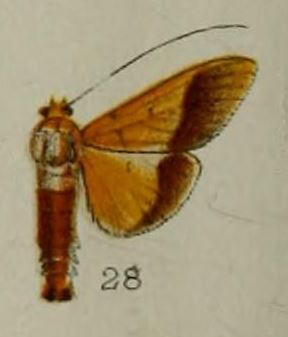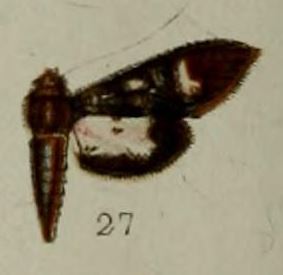
Syntomoides imaon, the handmaiden moth, is a moth of subfamily Arctiinae, subtribe Ctenuchina. The systematics of the subfamily has been revised. It was described by Pieter Cramer in 1780. It is well distributed in Sikkim, Khasi hills and throughout India Tamil Nadu, Kerala, Sri Lanka, Myanmar, Bangladesh, Nepal, and Hong Kong, Viet Nam.

Desmia is a genus of moths of the family Crambidae. The genus was erected by John O. Westwood in 1832.

Eressa confinis is a moth of the family Erebidae. It was described by Francis Walker in 1854. It is found in India, Bhutan, Sri Lanka, Myanmar, Taiwan and China.
Hyalaethea solomonis is a moth of the subfamily Arctiinae. It was described by George Hampson. It is found on the Solomon Islands.

Schistophleps bipuncta is a moth in the subfamily Arctiinae. It was described by George Hampson in 1891. It is found in India, Sri Lanka and Myanmar.

Indarbela is a genus of moths in the family Metarbelidae described by Thomas Bainbrigge Fletcher in 1922.
Chalcidoptera pryeri is a moth in the family Crambidae. It was described by George Hampson in 1898. It is found on Borneo.
Desmia odontoplaga is a moth in the family Crambidae described by George Hampson in 1898. It is found in Panama and Brazil.
Desmia parastigma is a moth of the family Crambidae described by Harrison Gray Dyar Jr. in 1914. It is found in Panama and Costa Rica.
Desmia pentodontalis is a moth of the family Crambidae described by George Hampson in 1989. It is found in Ecuador.
Desmia deploralis, the deploring desmia moth, is a moth in the family Crambidae. It was described by George Hampson in 1912. It is found in Paraguay, Cuba, Jamaica and Florida.

Desmia chryseis is a moth in the family Crambidae. It was described by George Hampson in 1898. It is found in Venezuela and Peru.

Desmia melaleucalis is a moth in the family Crambidae. It was described by George Hampson in 1899. It is found in Ecuador.
Desmia microstictalis is a moth in the family Crambidae. It was described by George Hampson in 1904. It is found in the Bahamas.
Pilocrocis coptobasis is a species of moth in the family Crambidae. It was described by George Hampson in 1899. It is found in Indonesia and Papua New Guinea, where it has been recorded from the D'Entrecasteaux Islands.
Syllepte methyalinalis is a moth in the family Crambidae. It was described by George Hampson in 1912. It is found in Guyana.
Syllepte tetrathyralis is a moth in the family Crambidae. It was described by George Hampson in 1912. It is found in New Guinea.
Syllepte desmialis is a moth in the family Crambidae. It was described by George Hampson in 1912. It is found in Nigeria.
Syllepte nasonalis is a moth in the family Crambidae. It was described by George Hampson in 1898. It is endemic to South Africa.
Ulopeza denticulalis is a species of moth in the family Crambidae. It was described by George Hampson in 1912. It is found in South Africa.



